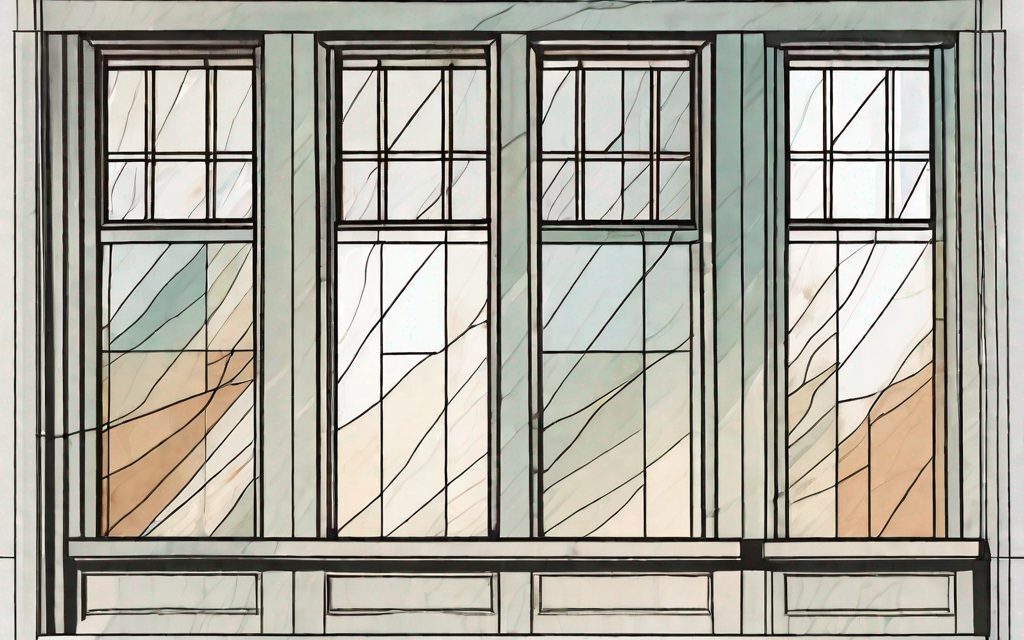In the world of architecture and interior design, transom windows play a significant role in enhancing both the functionality and overall aesthetics of a building. These unique window features have been around for centuries and continue to captivate homeowners and designers alike. If you’re unfamiliar with transom windows and their various types, purposes, installation processes, and maintenance, this comprehensive guide will provide you with all the essential information you need.
Understanding the Basics of Transom Windows
Definition and Purpose
Transom windows are horizontal windows located above doors or other windows. They typically run the width of the opening and are often narrower in height compared to standard windows. The main purpose of transom windows is to allow additional light and ventilation into a room while maintaining privacy and architectural integrity.
Transom windows date back to the 16th century and were initially used in grand, stately homes as a sophisticated architectural element. Over time, their popularity spread to a wider range of residential and commercial buildings, adding a touch of elegance and charm wherever they are installed.
Transom windows not only serve a functional purpose but also contribute to the aesthetic appeal of a building. They can enhance the overall design by adding visual interest and creating a sense of balance and symmetry. The placement of transom windows can also help create a connection between different spaces, allowing for a seamless flow of natural light and air.
Historical Background
Originally, transom windows were functional features that helped circulate air throughout a space before the advent of modern ventilation systems. In addition, they were designed to allow light to filter through the interior of a room, providing illumination at times when electricity was either limited or non-existent.
Transom windows became particularly popular during the Georgian and Victorian eras. During these periods, they were commonly seen in grand townhouses and ornate buildings, contributing to the overall architectural style and design. As architectural trends evolved, transom windows also underwent transformations in terms of materials and design, reflecting the prevailing architectural styles of the time.
During the Georgian era, transom windows were often made of wood and featured intricate detailing, such as decorative moldings and carvings. These windows symbolized wealth and status, showcasing the craftsmanship and attention to detail of the time.
In the Victorian era, transom windows continued to be popular, but there was a shift towards using different materials. Cast iron became common, allowing for more elaborate and ornate designs. Stained glass also gained popularity during this period, adding a touch of color and artistry to transom windows.
Today, transom windows can be found in various architectural styles, from traditional to contemporary. They continue to be valued for bringing in natural light, improving ventilation, and adding a touch of architectural elegance to any space. Transom windows remain a timeless feature that combines functionality and beauty, whether used in residential or commercial buildings.
Different Types of Transom Windows
Transom windows are a popular architectural feature that can add functionality and aesthetic appeal to any space. They are typically installed above doors or other windows, allowing natural light to flow into a room while maintaining privacy. In addition to their practical benefits, transom windows come in various types, each with unique characteristics and advantages.
Stationary Transom Windows
As the name suggests, stationary transom windows are fixed in place and cannot be opened or closed. They are primarily used to allow natural light into a room while maintaining privacy. These transom windows can be found in residential and commercial buildings, adding a touch of elegance to any space.
One of the key benefits of stationary transom windows is their ability to enhance the overall aesthetic appeal of a room. They come in a wide range of designs, from simple and minimalist to intricate and ornate, allowing homeowners and designers to choose the perfect style that complements the overall decor. Additionally, stationary transom windows can be customized with different types of glass, such as frosted or stained, to enhance privacy or add a decorative touch.
Another advantage of stationary transom windows is their ability to maximize the amount of natural light in a room. Installing these windows above doors or other windows they allows sunlight to enter the space from multiple angles, creating a bright and inviting atmosphere. This can be particularly beneficial in rooms without large windows or limited access to natural light.
Operable Transom Windows
Operable transom windows, on the other hand, offer the additional advantage of opening and closing. This feature provides an excellent opportunity for increased airflow and ventilation. Operable transom windows are commonly found in older buildings and homes with a historical or period design.
One of the main benefits of operable transom windows is their ability to improve indoor air quality. Opening the windows allows fresh air to flow into the room while stale air is expelled, creating a healthier and more comfortable living environment. This can be particularly useful in rooms that tend to get stuffy or lack proper ventilation, such as bathrooms or kitchens.
In addition to their practical benefits, operable transom windows can add nostalgia and charm to a space. They are often associated with traditional architectural styles, such as Victorian or Colonial, and can help create a sense of history and character. Homeowners who appreciate the beauty of vintage design elements often choose operable transom windows to enhance the overall aesthetic of their homes.
Furthermore, operable transom windows can be a tremendous energy-saving feature. Open windows during mild weather conditions allow homeowners to use natural ventilation instead of relying solely on air conditioning or fans. This can help reduce energy consumption and lower utility bills, making operable transom windows a sustainable and cost-effective choice.
Whether you opt for stationary or operable transom windows, incorporating these architectural elements into your space can elevate its design and functionality. From adding elegance and natural light to improving airflow and energy efficiency, transom windows are a versatile and timeless feature that can enhance any room.
The Architectural Significance of Transom Windows
Role in Ventilation and Natural Light
One of the primary roles of transom windows is to enhance the ventilation and natural light within a room. By strategically placing transom windows above doors or windows, air circulation is improved, particularly in spaces without proper access to exterior openings. This feature helps maintain a comfortable indoor environment and reduces the dependence on artificial lighting during the day.
Aesthetic Appeal and Design Flexibility
In addition to their functional advantages, transom windows offer a significant aesthetic appeal to any architectural design. They add visual interest by creating a harmonious balance between vertical and horizontal elements. Transom windows come in various shapes and sizes, allowing for endless design possibilities. From simple rectangular panes to elaborate stained glass patterns, transom windows offer an opportunity to showcase unique and individual design preferences.
Installation Process
Pre-Installation Considerations
Before the installation of transom windows, several essential considerations should be taken into account. These include the type of window frame, selecting appropriate glass, ensuring proper measurements, and evaluating the structural integrity of the building. It is also vital to consult local building codes and regulations to ensure compliance with safety standards.
Step-by-Step Installation Guide
The installation process for transom windows will vary depending on the type of window and the construction of the building. In general, the installation involves determining the location and size of the transom window, preparing the opening, securing the window in place, and properly sealing and weatherproofing the area. It is recommended to consult a professional or specialized contractor for the most accurate and efficient installation process.
Maintenance and Care
Cleaning and Repair Tips
Regular maintenance is key to ensuring transom windows’ longevity and optimal performance. Cleaning the glass surfaces regularly with a mild glass cleaner and a soft cloth will help keep them in pristine condition. Inspecting the window frames, hinges, and hardware for any signs of damage or wear is essential. Prompt repairs should be carried out if necessary to prevent further deterioration.
Longevity and Durability of
Transom windows, when properly maintained, can last for decades. The longevity and durability of transom windows largely depend on the quality of materials used during installation, regular upkeep, and protection them from external elements. Wooden frames may require periodic painting or sealing to prevent rot, while metal frames might require rust treatment and protection.
Ultimately, transom windows are more than just functional windows. They are architectural elements that add character, style, and a touch of history to any space. Whether you’re looking to enhance the ventilation, increase natural light, or elevate the overall aesthetic appeal of your home, transom windows are a timeless feature worth considering.


